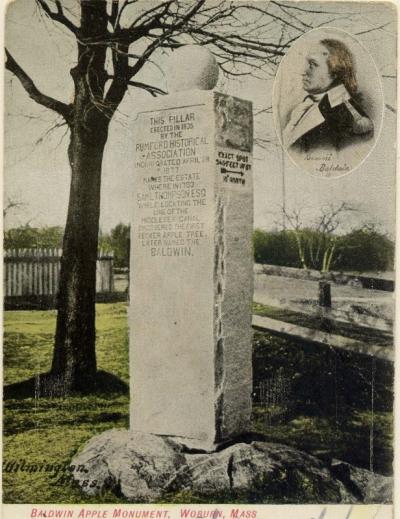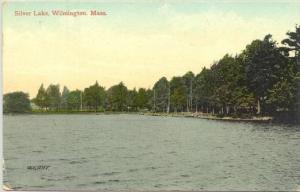Wilmington, Massachusetts
By: Terry McDermott
Writing in the late nineteenth century, local resident and amateur historian Lemuel C. Eames described the town of Wilmington, as follows:
Wilmington is situated in the northeast part of Middlesex County, and is bounded south by Woburn and Burlington, west by Billerica and Tewksbury, north by Andover and east by Reading and North Reading. It is sixteen miles north from Boston and the same distance west from Salem….. the placid Silver Lake should not be passed by…. The character of the soil is not very generally well celebrated for its production; yet a large portion of it will well reward judicious cultivation.[1]
Such a description of Wilmington, written as the town approached the 150th anniversary of its founding in 1880, describes a small rural town, known primarily for its agriculture and the beautiful scenery epitomized by Silver Lake. The earliest settlers in the area are believed to have arrived around 1665, establishing farms in this remote part of eastern Massachusetts known originally as Charlestown. The town of Wilmington was officially founded on September 25, 1730, when the General Court of Massachusetts (the state legislature) passed an act incorporating the new town, created from parts of territory in Woburn, Reading and later, Billerica. This action was in response to years of petitions from residents of the area who were requesting that a more local meeting house be built in these isolated territories locally identified with names such as Goshen, the Land of Nod, Ladder-Pole and Lebanon. By 1733 the town of Wilmington was well established and the desired meeting house was in place.
 For many decades, Wilmington remained a small, rural town. In the 1770’s, Wilmington citizens played a part in the founding of our nation, with local men participating in the struggle for independence that became known as the American Revolution. After the war, the town continued to be mostly a farming community, populated by descendants of the town’s founders, people with names like Harnden, Butters, Buck, Jacquith, Eames, and Rich. In the early nineteenth century, many local residents were experiencing some commercial success by cultivating hops and cranberries, as well as promoting the perfections of the locally discovered Baldwin apple, popularized by Woburn engineer and politician, Loammi Baldwin. In addition, the town’s first serious industry beyond farming was established around this time when Joseph Bond arrived in town and established a cracker factory that flourished for more than half a century. Although hop farming seems to have fallen out of favor early in the nineteenth century, the cracker factory continued in operation until 1864 when an unfortunate fire destroyed the company’s bake houses, as well as the local church, which was located across the street from the factory.
For many decades, Wilmington remained a small, rural town. In the 1770’s, Wilmington citizens played a part in the founding of our nation, with local men participating in the struggle for independence that became known as the American Revolution. After the war, the town continued to be mostly a farming community, populated by descendants of the town’s founders, people with names like Harnden, Butters, Buck, Jacquith, Eames, and Rich. In the early nineteenth century, many local residents were experiencing some commercial success by cultivating hops and cranberries, as well as promoting the perfections of the locally discovered Baldwin apple, popularized by Woburn engineer and politician, Loammi Baldwin. In addition, the town’s first serious industry beyond farming was established around this time when Joseph Bond arrived in town and established a cracker factory that flourished for more than half a century. Although hop farming seems to have fallen out of favor early in the nineteenth century, the cracker factory continued in operation until 1864 when an unfortunate fire destroyed the company’s bake houses, as well as the local church, which was located across the street from the factory.
 Shortly after the Bond Cracker Factory was destroyed and the business relocated to Boston, Franklin Perry established a tannery about a mile away on the same road. The tannery became Wilmington’s next big employer and operated well into the twentieth century. But throughout the nineteenth century, Wilmington was becoming less isolated and less strictly rural as improvements in transportation made the town much more accessible to outsiders. First, the Middlesex Canal, followed soon thereafter by the installation of railroads, allowed people and goods to travel more freely than thought possible in an earlier era. By the end of the nineteenth century, several train lines brought residents of the city out to the country in Wilmington, where people could enjoy fresh air, fresh food, country living and Silver Lake. In fact, improved transportation options were an especially significant boon to Wilmington’s Silver Lake, for the same train tracks that could bring people to the lake for recreation could also transport harvested ice back to the city where it was greatly valued in food preservation.
Shortly after the Bond Cracker Factory was destroyed and the business relocated to Boston, Franklin Perry established a tannery about a mile away on the same road. The tannery became Wilmington’s next big employer and operated well into the twentieth century. But throughout the nineteenth century, Wilmington was becoming less isolated and less strictly rural as improvements in transportation made the town much more accessible to outsiders. First, the Middlesex Canal, followed soon thereafter by the installation of railroads, allowed people and goods to travel more freely than thought possible in an earlier era. By the end of the nineteenth century, several train lines brought residents of the city out to the country in Wilmington, where people could enjoy fresh air, fresh food, country living and Silver Lake. In fact, improved transportation options were an especially significant boon to Wilmington’s Silver Lake, for the same train tracks that could bring people to the lake for recreation could also transport harvested ice back to the city where it was greatly valued in food preservation.
As the town grew, it adopted the institutions of successful towns. New churches were established, as well as a district school system which grew into the school department the town enjoys today. The town established a library which existed in various town buildings until 1969 when today’s library building was built. Rudimentary police and fire services were professionalized in the early twentieth century shortly after the town adopted an image of the legendary Whitefield Elm Tree – site of a mythical sermon preached by the fiery evangelist, George Whitefield - to serve as the focal point of the official town seal.
With a population well under 1,000 people until the 1880’s, the twentieth century brought a dramatic surge in residents to the area. When Interstate 93 cut through the town in the late 1950’s, the industrial boom that had begun earlier in the decade led to the town’s population more than doubling in less than twenty years. Farmland was sold. Some of that land became suburban housing, but much of the land, especially that most accessible to the highways, was developed into industrial parks and a wide variety of businesses began operating in the area. No longer were people coming to Wilmington to farm – many of them were buying a suburban home and taking desk jobs in the town or commuting to Boston via train or highway. New schools were in constant demand as the baby boom in Wilmington was well under way. It was not until the dawning of the twenty-first century that Wilmington’s school capacity was in line with the town’s student population.
Today, the town of Wilmington, with a population a little over 22,000 as of the 2010 census, is a vibrant bedroom community with services second to none in the area. In addition to the police, fire, library and school departments, the town supports an active senior center, a recreation department, veteran’s services, a town museum and all the other services that keep a town viable. The trains still take commuters to Boston and Silver Lake still offers recreational opportunities, although the lake is now a quiet neighborhood of residential homes and not a vacation mecca. The town’s sense of community is particularly evident at its renowned annual Fun on the Fourth carnival and fireworks celebration leading up to the 4th of July holiday. Satisfied residents were further pleased in 2010, when BusinessWeek magazine declared Wilmington one of the most affordable suburbs in Massachusetts. As Wilmington’s cherished local newspaper, the Wilmington Town Crier, stated at the time: “What so many Wilmington residents have known for years is now broadcast on the national stage…” Wilmington is a great place to live!
- [1] History of Middlesex County, Massachusetts by Samuel Adams Drake, 1880
- Drake, Samuel Adams, and Lemuel C. Eames. History of Middlesex County, Massachusetts. II, Boston, MA, Estes and Lauriat, 1880.
- Miller, Jayne W. “One of America's Best Affordable Suburbs.” Wilmington Town Crier, 10 Mar. 2010, pp. 1 & 17.
- Passmore, Adele. 250th Anniversary, Wilmington, Massachusetts, 1730-1980. Wilmington, MA, 250th Anniversary Committee, 1980.
- Simmons, Minister, Rev. Arthur A. History, Year Book and Church Directory of the First Congregational Church, Wilmington, Mass. Wilmington, MA, First Congregational Church.
- Town of Wilmington, “Town of Wilmington Open Space and Recreation Plan.” Town of Wilmington Open Space and Recreation Plan, July 2015
